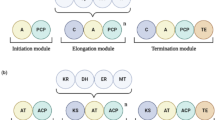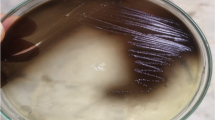Abstract
Many Salmonella Typhimurium isolates produce type 1 fimbriae and exhibit fimbrial phase variation in vitro. Static broth culture favours the production of fimbriae, while solid agar medium inhibits the generation of these appendages. Little information is available regarding whether S. Typhimurium continues to produce type 1 fimbriae during in vivo growth. We used a type 1 fimbrial phase-variable strain S. Typhimurium LB5010 and its derivatives to infect RAW 264.7 macrophages. Following entry into macrophages, S. Typhimurium LB5010 gradually decreased the transcript levels of fimbrial subunit gene fimA, positive regulatory gene fimZ, and global regulatory gene lrp. A similar decrease in transcript levels was detected by RT-PCR when the pH of static broth medium was shifted from pH 7 to a more acidic pH 4. A fimA-deleted strain continued to multiply within macrophages as did the parental strain. An lrp deletion strain was unimpaired for in vitro growth at pH 7 or pH 4, while a strain harboring an lrp-containing plasmid exhibited impaired in vitro growth at pH 4. We propose that acidic medium, which resembles one aspect of the intracellular environment in a macrophage, inhibits type 1 fimbrial production by down-regulation of the expression of lrp, fimZ and fimA.







Similar content being viewed by others
Reference
Alpuche-Aranda CM, Swanson JA, Loomis WP and Miller SI 1992 Salmonella typhimurium activates virulence gene transcription within acidified macrophage phagosomes. Proc. Natl. Acad. Sci. USA 89 10079–10083
Althouse C, Patterson S, Fedorka-Cray P and Isaacson RE 2003 Type 1 fimbriae of Salmonella enterica serovar Typhimurium bind to enterocytes and contribute to colonization of swine in vivo. Infect. Immun. 71 6446–6452
Baek CH, Wang S, Roland KL and Curtiss III R 2009 Leucine-responsive regulatory protein (Lrp) acts as a virulence repressor in Salmonella enterica serovar Typhimurium. J. Bacteriol. 191 1278–1292
Bearson S, Bearson B and Foster JW 1997 Acid stress responses in enterobacteria. FEMS Microb. Lett. 147 173–180
Brinton CC Jr 1965 The structure, function, synthesis and genetic control of bacterial pili and a molecular model of DNA and RNA transport in gram negative bacteria. Trans . NY Acad. Sci. 27 1003–1054
Buchmeier NA and Heffron F 1989 Intracellular survival of wide-type Salmonella typhimurium and macrophage-sensitive mutants in diverse populations of macrophages. Infect. Immun. 57 1–7
Bullas LR and Ryu JI 1983 Salmonella typhimurium LT2 strains which are r- m+ for all three chromosomally located systems of DNA restriction and modification. J. Bacteriol. 156 471–474
Chuang YC, Wang KC, Chen YT, Yang CH, Men SC, Fan CC, Chang LH and Yeh KS 2008 Identification of the genetic determinants of Salmonella enterica serotype Typhimurium that may regulate the expression of the type 1 fimbriae in response to solid agar and static broth culture conditions. BMC Microbiol. 8 126
Clegg S and Gerlach GF 1987 Enterobacterial fimbriae. J. Bacteriol. 169 934–938
Clegg S, Hancox L and Yeh KS 1996 Salmonella typhimurium fimbrial phase variation and FimA expression. J. Bacteriol. 178 542–545
Dagert M and Ehrlich SD 1979 Prolonged incubation in calcium chloride improves the competence of Escherichia coli cells. Gene 6 23–28
Duguid JP, Anderson ES and Campbell I 1966 Fimbriae and adhesive properties in Salmonella. J. Pathol. Bacteriol. 92 107–138
Ferrario M, Ernsting BR, Borst DW, Wiese DE 2nd, Blumenthal RM and Matthews RG 1995 The leucine-responsive regulatory protein of Escherichia coli negatively regulates transcription of ompC and micF and positively regulates translation of ompF. J. Bacteriol. 177 103–113
Gibbons HS, Kalb SR, Cotter RJ and Raetz CR 2005 Role of Mg2+ and pH in the modification of Salmonella lipid A after endocytosis by macrophage tumour cells. Mol. Microbiol. 55 425–440
Goldberg MB and Rubin RH 1988 The spectrum of Salmonella infection. Infect. Clin. North Am. 2 571–598
Guibourdenche M, Roggentin P, Mikoleit M, Fields PI, Bockemuhl J, Grimont PA and Weill FX 2010 Supplement 2003–2007 (No. 47) to the White-Kauffmann-LeMinor scheme. Res. Microbiol. 161 26–29
Guo A, Lasaro MA, Sirard JC, JKraehenbuhl JP and Schifferli DM 2007 Adhesion-dependent binding and uptake of Salmonella enterica serovar Typhimurium by dendritic cells. Microbiology 153 1059–1069
Letunic I, Copley RR, Pils B, Pinkert S, Schultz J and Bork P 2006 SMART 5: domains in the context of genomes and networks. Nucleic Acids Res. 34 257–260
Lucchini S, McDermott P, Thompson A and Hinton JC 2009 The H-NS-like protein StpA represses the RpoS (sigma 38) regulon during exponential growth of Salmonella Typhimurium. Mol. Microbiol. 74 1169–1186
McFarland KA, Lucchin S, Hinton JCD and Dorman CJ 2008 The leucine-responsive regulatory protein, Lrp, activates transcription of the fim operon in Salmonella enterica serovar Typhimurium via the fimZ regulatory gene. J. Bacteriol. 190 602–612
Misselwitz B, Kreibich SK, Rout S, Stecher B, Periaswamy B and Hardt WD 2011 Salmonella enterica serovar Typhimurium binds to HeLa cells via Fim-mediated reversible adhesion and irreversible type three secretion system 1-mediated docking. Infect. Immun. 79 330–341
Old DC and Duguid JP 1970 Selective outgrowth of fimbriate bacteria in static liquid medium. J. Bacteriol. 103 447–456
Old DC, Corneil I, Gibson LF, Thomson AD and Duguid JP 1968 Fimbriation, pellicle formation and the amount of growth of salmonellas in broth. J. Gen. Microbiol. 51 1–16
Pfeifer CG, Marcus SL, Steele-Mortimer O, Knodler LA and Finlay BB 1999 Salmonella typhimurium virulence genes are induced upon bacterial invasion into phagocytic and nonphagocytic cells. Infect. Immun. 67 5690–5698
Rathman M, Sjaastad MD and Falkow S 1996 Acidification of phagosomes containing Salmonella typhimurium in murine macrophages. Infect. Immun. 64 2765–2773
Saini S, Pearl JA and Rao CV 2009 Role of FimW, FimY and FimZ in regulating the expression of type 1 fimbriae in Salmonella enterica serovar Typhimurium. J. Bacteriol. 191 3003–3010
Sato M, Machida K, Arikado E, Saito H, Kakegawa T and Kobayashi H 2000 Expression of outer membrane proteins in Escherichia coli growing at acid pH. Appl. Environ. Microbiol. 66 943–947
Sonden B and Uhlin BE 1996 Coordinated and differential expression of histone-like proteins in Escherichia coli: regulation and function of the H-NS analog StpA. EMBO J. 15 4970–4980
Swenson DL and Clegg S 1992 Identification of ancillary fim genes affecting fimA expression in Salmonella typhimurium. J. Bacteriol. 174 7697–7704
Tinker JK and Clegg S 2000 Characterization of FimY as a coactivator of type 1 fimbrial expression in Salmonella enterica serovar Typhimurium. Infect. Immun. 68 3305–3313
Tinker JK and Clegg S 2001 Control of FimY translation and type 1 fimbrial production by the arginine tRNA encoded by fimU in Salmonella enterica serovar Typhimurium. Mol. Microbiol. 40 757–768
Tinker JK, Hancox LS and Clegg S 2001 FimW is a negative regulator affecting type 1 fimbrial expression in Salmonella enterica serovar Typhimurium. J. Bacteriol. 183 435–442
van der Velden AWM, BäumLer AJ, Tsolis RM and Heffron F 1998 Multiple fimbrial adhesins are required for full virulence of Salmonella typhimurium in mice. Infect. Immun. 66 2803–2808
Vazquez-Torres A, Jones-Carson J, Mastroeni P, Ischiropoulos H and Fang FC 2000 Antimicrobial actions of the NADPH phagocyte oxidase and inducible nitric oxide synthase in experimental salmonellosis. I. Effects on microbial killing by activated peritoneal macrophages in vitro. J. Exp. Med. 192 227–236
Yeh KS, Hancox LS and Clegg S 1995 Construction and characterization of a fimZ mutant of Salmonella typhimurium. J. Bacteriol. 177 6861–6865
Acknowledgements
This work was supported by grant NSC98-2313-B-038-001-MY3 from the National Science Council, Taiwan, to KSY.
Author information
Authors and Affiliations
Corresponding author
Additional information
Corresponding editor: DURGADAS P KASBEKAR
MS received 07 February 2013; accepted 10 June 2013
Corresponding editor: Durgadas P Kasbekar
[Wang K-C, Hsu Y-H, Huang Y-N, Chen T-H, Lin J-H, Hsuan S-L, Chien M-S, Lee W-C and Yeh K-S 2013 A low-pH medium in vitro or the environment within a macrophage decreases the transcriptional levels of fimA, fimZ and lrp in Salmonella enterica serovar Typhimurium. J. Biosci. 38 1–9] DOI 10.1007/s12038-013-9347-2
Rights and permissions
About this article
Cite this article
Wang, KC., Hsu, YH., Huang, YN. et al. A low-pH medium in vitro or the environment within a macrophage decreases the transcriptional levels of fimA, fimZ and lrp in Salmonella enterica serovar Typhimurium. J Biosci 38, 499–507 (2013). https://doi.org/10.1007/s12038-013-9347-2
Received:
Accepted:
Published:
Issue Date:
DOI: https://doi.org/10.1007/s12038-013-9347-2




